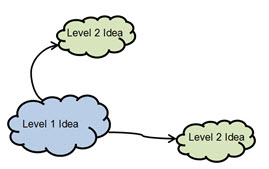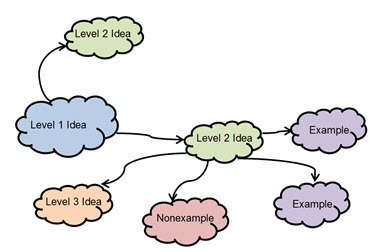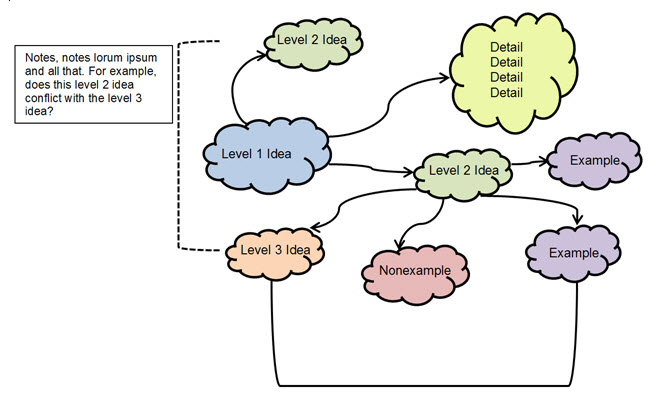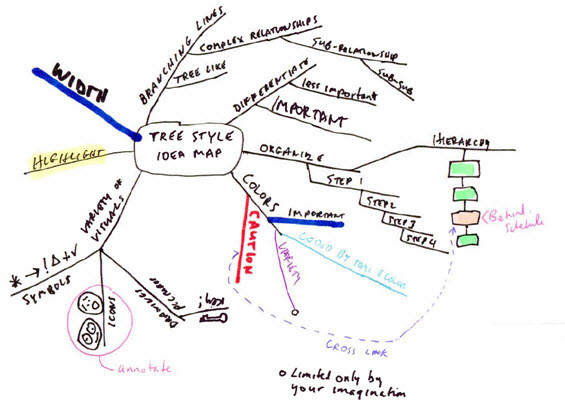Description
Idea mapping–also called mind mapping–is a note-taking or outlining (or creative thinking) method for gettiing ideas down on paper. It has some advantages over outlining in the following ways:
- Idea mapping is nonlinear, Ideas can grow and be mapped organically. Many ideas do not proceed in a straight line. Not only are ideas recursive (they flow back and forth while in the process of development, but they appear in branches rather than in rows.
- An idea can be connected to several other ideas, not just the ideas before and after it in sequence.
- It is visual and spatial, giving you a quickly processed, comprehensive overview of the thought universe you are working with. More important or higher level ideas can be given larger shapes to show their relative importance, so yu can see at a glance where the primary concepts are and how they are supported by secondary ideas.
- It’s easier to add new information and show its relatedness to what you previously have down,especially if you are working on paper. Simply draw another connector and write.
Types of Idea Map

While there are many variants, the most common types are the cloud-circle-flowchart style and the treebranch style.
Here is an example of how a simple cloud-style idea map might be created. First, the main idea (sometimes called a Level 1 idea) is written down in the center of the notetaking paper, and then a cloud is drawn around it. (Drawing the shapes first usually results in shapes too small to fit in the content, resulting in an ugly map. If you write the words first and then draw the cloud around them, the words will always fit perfectly.)
Next, a supporting idea (or two) is written down. Then, to show the connection between the ideas, draw arrowed lines, with the arrow pointing from the superior idea to the subordinate idea. In the example here, color is also used to allow a quick understanding of which and how many different levels of ideas are present.

From this beginning, you can continue adding Level 2 ideas, or you can add Level 3 ideas, examples, nonexamples, supporting arguments, counterarguments, or whatever fits the material you are mapping. In our example here, we have added a couple of examples, a nonexample, and a Level 3 idea.
(A nonexample is something that is not an example of the subject under discussion. If, for example, you are mapping “Fruits and Vegetables,” under fruits, you might have a cloud that says, “A tomato is not a fruit.” Nonexamples help clarify and avoid confusion.)
Note the use of color to allow a quick distinguishing among all the elements.
The flexibility of idea maps can be shown by the ease of adding information wherever there is room on the page and simply drawing an arrow to the cloud idea it applies to. And if the added information applies to more than one idea, multiple connecting lines can be drawn.
Additionally, you can write notes anywhere, you can bracket sections of the map that have a special relationship or need special commentary, and you can connect any clouds to any others when that is desirable. This is where the map shows its its strength and flexibility, too. By escaping linear connectivity, you are enabled to display more complex relationships.

Tree Style
An alternate style of idea mapping is the tree or branching map. This style provides the same benefits as the connected-shape style, with the additional advantage of creating easily visualized sub-levels. If you will have several levels (main, sub, sub-sub, sub-sub-sub), then the tree style might work for that application.

Benefits of Idea Mapping
- The ability to add an idea and connect it anywhere, even to multiple other ideas, allows the representation of a complex integration of ideas.
- The flexibility to add new nodes anywhere offers the ability to grow a set of thoughts organically, adding in what may seem a random fashion, while preserving a hierarchical, clear relationship among all the pieces.
- Symbols and graphics (pictures, diagrams) can be added and connected by links.
- When you study your notes in the form of an idea map, your mind remembers the picture. An image is easier to remember than an outline or a set of notes. You’ll recall the general shape of your map and be more likely to fill in the text on the lines.
Method
You can use any of several, free, online and downloadable idea mapping (also called mind mapping) software applications, you can use a word processing program that has insertalble shapes. However, to get started, you might learn and practice with a hand drawn map. Just as notetaking increases learning through the physical act of taking down the notes, so drawing out your idea map will help you learn. You can keep some colored pens or markers handy, draw in various sizes and colors, and reinforce certain clouds or balloons by running your pen or pencil over the shape again each time you think about it.
- For some reason, we tend to think wider rather than taller, so it’s a good idea to turn the paper to landscape orientation.
- Write the idea first, then draw the circle, cloud, square, rectangle, oval, hexagon, or other shape around it.
- Put your main idea in the center of the page.
- Depending on the size of your paper (try 11″ by 17″ sometime!) keep your idea descriptions to a couple of words or short phrases. (With larger paper, you can use more words to describe each idea.)
For a really good set of examples of idea maps, use Google’s Advanced Image Search on “mind map.”
For free mind mapping software, do a Google search on “free mind mapping software.”
![]()
You can create a great comparison test (to determine your maximum effectiveness) and at the same time deeply reinforce your learning by using both a traditional outline format and an idea map for the same material (reading, lecture, video, etc.). Try one format first and then convert it to the other. Then for then for the next project, create the other format first and then convert that.
Ask yourself
- Which format is more flexible?
- Which format helps you organize your ideas better?
- Which seems easier to create as you listen or read?
- Which provides more benefits during review and studying fo tests?